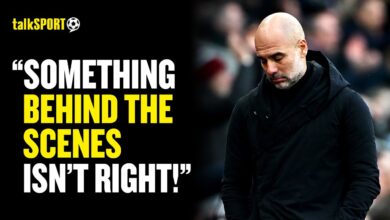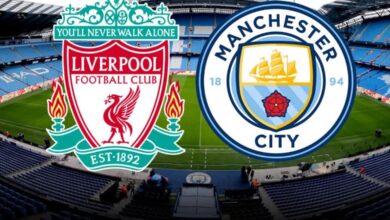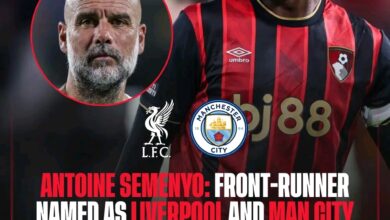Manchester City Edging Closer to Landmark Signing of Promising Midfielder from Premier League Rivals Liverpool

In what could prove to be one of the most significant youth transfers of the summer window, Manchester City are reportedly on the cusp of completing a deal that would see promising young midfielder Kaylum Moss make the controversial switch from Liverpool’s academy to the Etihad Campus. The potential acquisition has sent ripples through the football community, highlighting the increasingly competitive nature of youth recruitment between England’s elite clubs.
According to renowned transfer journalist Fabrizio Romano, whose reliability in the transfer market has made him a trusted source for football fans worldwide, Manchester City have made substantial progress in their pursuit of the Liverpool academy star. The Italian journalist, who has built a reputation for breaking major transfer news across Europe’s top leagues, revealed the latest developments through his social media channels, confirming that negotiations between the two Premier League giants are advancing positively.
Romano’s update, shared with his millions of followers on X (formerly Twitter), provided crucial insight into the current state of negotiations: “Manchester City are closing in on one more signing for the Academy, Kaylum Moss from Liverpool. Kaylum’s highly rated as a big talent for U15 level, Manchester City are working on key details with Liverpool.”
The revelation that City are “working on key details” suggests that the fundamental framework of the deal has been established, with both clubs now focused on finalizing the intricate aspects of what represents a significant investment in future talent. Such negotiations at youth level often involve complex compensation packages, development clauses, and future sell-on percentages that can prove as intricate as senior-level transfers.
Understanding Kaylum Moss: The Rising Star
At just 15 years of age, Kaylum Moss has already established himself as one of the most exciting prospects within Liverpool’s prestigious academy system. The Reds’ youth development program, which has produced world-class talents including Steven Gerrard, Raheem Sterling, and Trent Alexander-Arnold, is widely regarded as one of the finest in English football. For a player to stand out within such an environment speaks volumes about their potential and ability.
Moss operates primarily as a central midfielder, a position that has become increasingly crucial in modern football’s tactical evolution. His playing style, according to scouts who have observed him regularly, combines technical proficiency with an advanced understanding of the game that belies his tender years. The young midfielder possesses the kind of footballing intelligence that cannot be taught, coupled with the technical skills that have been honed through Liverpool’s comprehensive training programs.
What sets Moss apart from his contemporaries is not just his individual brilliance, but his ability to influence games at youth level consistently. Reports suggest that he has been instrumental in Liverpool’s youth teams’ recent successes, demonstrating leadership qualities and match-winning capabilities that have caught the attention of talent spotters across the Premier League.
The midfielder’s development has been carefully monitored by Liverpool’s coaching staff, who have implemented a structured progression plan designed to maximize his potential. However, the allure of Manchester City’s state-of-the-art facilities and proven track record of developing young talent has evidently proven too attractive to resist.
Manchester City’s Youth Revolution
Manchester City’s interest in Moss is emblematic of their broader strategic approach to youth development, which has undergone a revolutionary transformation since the club’s takeover by the City Football Group. The investment in the Etihad Campus, a world-class training facility that cost over £200 million to construct, represents one of the most significant commitments to youth development in world football.
The facility, which spans 80 acres in East Manchester, houses not only the first team’s training operations but also serves as the hub for the club’s comprehensive academy system. With 16.5 pitches, including a full-size replica of the Etihad Stadium pitch, the campus provides young players with an environment that mirrors the professional standards they aspire to reach.
City’s academy has already begun to bear fruit, with graduates like Phil Foden establishing themselves as key players in Pep Guardiola’s first team. Foden’s journey from academy prospect to Premier League and Champions League winner serves as a powerful example of the pathways available to young talents within the City system. This success story has undoubtedly played a role in attracting players like Moss, who can see a clear route to first-team football if they continue their development trajectory.
The club’s commitment to youth development extends beyond mere infrastructure. City have invested heavily in recruiting some of the finest youth coaches from around the world, creating an environment where young players receive expert guidance at every stage of their development. The coaching philosophy implemented throughout the academy system mirrors that of the first team, ensuring that players who progress through the ranks are already familiar with the tactical concepts and playing styles they will encounter at senior level.
The Liverpool Perspective
For Liverpool, the potential loss of Kaylum Moss represents a significant blow to their youth development ambitions. The Reds have long prided themselves on their ability to nurture homegrown talent, with the club’s academy serving as a source of both first-team players and valuable transfer income over the years.
Liverpool’s Kirkby Academy, which underwent a £50 million redevelopment to create world-class facilities, has been central to the club’s long-term strategic planning. The loss of promising talents like Moss to domestic rivals represents not just a sporting setback but also a potential financial loss, given the significant investment required to develop players from grassroots level to professional standard.
The Merseyside club’s academy has traditionally focused on developing players with a strong connection to the local community and club culture. This approach has yielded remarkable success, with graduates often displaying exceptional commitment and understanding of Liverpool’s values and playing philosophy. However, the increasing competition from financially powerful rivals has made it increasingly challenging to retain the most promising talents throughout their development journey.
Liverpool’s coaching staff will undoubtedly be disappointed by Moss’s potential departure, particularly given the time and resources invested in his development. The club’s youth coaches have worked extensively with the midfielder, implementing personalized training programs designed to maximize his potential and prepare him for eventual first-team integration.
The Broader Context of Youth Transfers
The potential transfer of Kaylum Moss highlights the increasingly competitive landscape of youth football recruitment in England. Premier League clubs are investing unprecedented sums in their academy systems, creating an environment where the most promising young talents are subject to intense competition from multiple clubs.
This competition has led to significant inflation in compensation fees for young players, with clubs often required to pay substantial sums to secure talents who have yet to play professional football. The investment is justified by the potential returns, both sporting and financial, that can be generated by successfully developing young players into first-team stars.
The regulatory framework governing youth transfers in England has evolved significantly in recent years, with the introduction of the Elite Player Performance Plan (EPPP) creating a structured system for compensating clubs when young players move between academies. This system has provided greater clarity and fairness in youth transfers while ensuring that clubs investing in development are adequately compensated when their players move elsewhere.
However, the emotional and sporting impact of losing promising young talents extends beyond financial considerations. For clubs like Liverpool, which have built their identity around developing local talent and maintaining strong community connections, the loss of players like Moss represents a challenge to their traditional approach and values.
Tactical and Strategic Implications
From a tactical perspective, Moss’s potential arrival at Manchester City would provide Pep Guardiola and his coaching staff with another versatile option for future squad planning. The Spanish manager has consistently demonstrated his ability to integrate young players into his tactical systems, with several academy graduates already making significant contributions to the first team.
Guardiola’s preference for technically gifted midfielders who can operate in multiple positions makes Moss an ideal fit for City’s long-term planning. The young midfielder’s ability to play various roles within the midfield structure provides tactical flexibility that aligns perfectly with Guardiola’s fluid approach to team selection and formation.
The integration of young players into City’s system has been carefully managed, with the club implementing a graduated approach that allows talents to develop progressively through various levels of competition. This methodology has proven successful with players like Cole Palmer and James McAtee, who have both benefited from structured development programs before making their mark in professional football.
Financial Considerations
While the specific financial details of the potential transfer have not been disclosed, youth transfers of this magnitude typically involve substantial compensation packages that reflect the investment made by the selling club. Liverpool’s development of Moss over several years represents a significant financial outlay that must be appropriately compensated in any transfer agreement.
Manchester City’s financial resources, bolstered by their ownership structure and commercial success, provide them with significant advantages in youth recruitment battles. The club’s ability to offer competitive compensation packages, combined with superior facilities and development pathways, creates a compelling proposition for young talents and their families.
The long-term financial implications of successful youth development cannot be understated. Players who progress through academy systems to become first-team regulars provide exceptional value, with their development costs minimal compared to the transfer fees required to acquire equivalent talents in the open market.
Looking Ahead: Future Implications
The potential signing of Kaylum Moss represents more than just another youth acquisition for Manchester City. It symbolizes the club’s commitment to building a sustainable model of success based on developing exceptional young talents alongside strategic senior signings.
For Moss himself, the move to City would represent both an opportunity and a challenge. The superior facilities and coaching available at the Etihad Campus provide an ideal environment for continued development, while the competitive nature of City’s academy system will push him to reach new levels of performance.
The teenager’s development over the coming years will be closely monitored by football observers, who will be keen to assess whether he can fulfill the potential that has attracted such significant interest from one of England’s most successful clubs.
Conclusion
As Manchester City edge closer to completing the signing of Kaylum Moss from Liverpool, the football world watches with interest to see how this potential transfer unfolds. The deal represents the increasingly competitive nature of youth recruitment in modern football, where the battle for the brightest young talents has become as intense as the pursuit of established stars.
For City, the acquisition would represent another step in their long-term strategic planning, adding a player of exceptional potential to their already impressive academy system. For Liverpool, the loss would serve as a reminder of the challenges facing even the most established academies in retaining their brightest prospects.
Regardless of the outcome, the interest in Moss highlights the importance of youth development in modern football and the significant investments being made by clubs to secure the stars of tomorrow. As negotiations continue between these two Premier League giants, the football community eagerly awaits the resolution of what has become one of the most intriguing youth transfers of the summer window.
The story of Kaylum Moss serves as a fascinating case study in the modern dynamics of youth football, where traditional loyalties and local connections increasingly compete with state-of-the-art facilities and enhanced development opportunities. Whatever the outcome, his journey will undoubtedly be watched with great interest by football fans and industry professionals alike, as yet another chapter in the ongoing evolution of English football’s youth development landscape unfolds.















